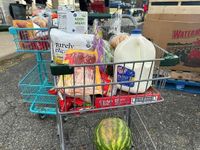The impact of the ongoing government shutdown, now stretching past its third week, is rippling through American households, workplaces, and communities with a force that few anticipated. As political gridlock in Washington continues, millions of families across the country are bracing for the possibility that critical federal nutrition programs could be halted, while tens of thousands of federal employees and contractors are left scrambling for financial lifelines.
At the heart of the crisis are the Supplemental Nutrition Assistance Program (SNAP) and the Special Supplemental Nutrition Program for Women, Infants, and Children (WIC), both federally funded initiatives that help low-income Americans put food on the table. According to No Kid Hungry, a national advocacy group, the situation was already dire for many Floridians before the shutdown, but the stalemate has introduced new levels of uncertainty and hardship. Sky Beard, Florida Director for No Kid Hungry, put it plainly: “It was incredibly difficult pre-government shutdown for a lot of folks across the state, and now we’re in a precarious situation across the state of Florida.”
Beard warns that if funding for these programs is not restored by November 1, millions of families who rely on SNAP and WIC may not receive benefits. “We really urge USDA at this particular time to release any available funds. There are federal contingency funds in place for this very reason — to find other sources of funding — so these programs such as SNAP and WIC can continue for the month of November,” Beard said, as reported by local media in Orlando.
The data underscore the growing distress. A recent report from No Kid Hungry reveals that rising food prices have forced more than half of Floridian families into deeper debt over the past year. Even more alarming, two-thirds of those surveyed said they’re having to make agonizing choices between buying groceries and paying for other essentials like gas, rent, or health care. As the shutdown drags on, food banks such as Second Harvest are preparing for a surge in demand from families who have never before sought such assistance. Stephanie Palacios from Second Harvest Food Bank explained, “With these benefits being suspended, we anticipate that even more neighbors who were either already utilizing pantries or neighbors who’ve never utilized a pantry in their life are going to come to pantries associated with Second Harvest.”
Food banks and advocacy groups are mobilizing to fill the gap, but the scale of need threatens to outstrip their resources. “The food bank is committed to doing whatever we can to utilize whatever funds we have available to us and appeal to the community for support, to support our pantries and neighbors who may be seeking help at this time,” said Palacios. Advocates like Beard emphasize that children are often the first to feel the pain when benefits disappear: “We have families struggling in every community. We need all of these services working together in order to support families and make sure kids have what they need.”
The federal response, however, has been marked by sharp disagreement and legal wrangling. According to a Department of Agriculture memo obtained by the Associated Press and first reported by Axios, the Trump administration is refusing to use approximately $5 billion in contingency funds to keep SNAP benefits flowing into November. The memo argues that “contingency funds are not legally available to cover regular benefits,” reserving those funds for disaster response—such as the looming threat of Tropical Storm Melissa—rather than for ongoing nutrition assistance. The document states, “The appropriations for regular benefits no longer exists.”
This stance has sparked outrage among Democratic lawmakers and advocacy organizations, who have been pressing the administration to tap into the contingency reserves. House Democratic leader Hakeem Jeffries, speaking to reporters on October 24, asserted that the administration has the resources to ensure continued food assistance, accusing Republicans of “trying to weaponize hunger” and describing the refusal to act as a “disgusting dereliction of duty.” The memo, meanwhile, places blame on Congressional Democrats for blocking government funding, stating that November SNAP benefits would be paid on time “if not for Congressional Democrats blocking government funding.”
The program’s reach is vast—helping about one in eight Americans buy groceries—and the potential suspension of benefits has become a flashpoint in the broader debate over responsibility for the shutdown. The impasse began on October 1, when a short-term funding measure failed to advance in the Senate, and has since become the second-longest shutdown on record.
Some states are taking matters into their own hands. Officials in Louisiana, Vermont, and Virginia have pledged to keep food aid flowing to recipients, using state resources to bridge the gap if federal funding stalls. Yet these efforts are hampered by technical and legal obstacles, and some states have had to warn SNAP recipients to prepare for the possibility that their benefits will stop.
Federal workers are also feeling the squeeze. Nearly 20,600 furloughed federal employees filed for unemployment benefits during the first three weeks of the shutdown, according to Andrew Stettner of The Century Foundation. This marks the highest level of initial claims since the 35-day shutdown that ended in January 2019. Maryland and Texas have seen the largest numbers of claims, each topping 3,100 filings. For many, the process has been fraught with frustration and delays. One furloughed USDA worker in Massachusetts, who asked to remain anonymous, filed for unemployment on October 1 but is still waiting for approval more than three weeks later. “The rent is due on November 1,” she explained, highlighting the immediate pressures faced by many.
Even when benefits are approved, payments are often delayed for weeks or even months, and the amounts fall short of workers’ regular pay. In Washington, DC, the maximum weekly payment is $444; in Maryland, it’s $430; and in Virginia, just $378. Many federal employees are reluctant to file claims because they must repay the benefits if they eventually receive back pay—a guarantee that the Trump administration has called into question, despite a 2019 law mandating retroactive compensation.
States such as Washington, Maryland, and Utah are working to streamline the claims process, offering webinars, dedicated web pages, and FAQs for affected workers. Still, the hurdles are significant. Ben Emmel, a senior analyst at the Government Accountability Office and president of a federal workers’ union, noted that even after resolving identity verification issues, the payments he expects to receive will only cover basic needs for his family of six.
Contractors, who make up a significant portion of the federal workforce, are often in an even more precarious position. They lack the same guarantees of back pay and can face additional barriers to claiming unemployment benefits. Sharon, a contractor for the Drug Enforcement Administration in Washington, DC, described her experience seeking help as “super frustrated” after waiting in line at an unemployment office and still not receiving clear guidance.
Communities and industries are stepping up to support those caught in the crossfire. Airports across the country have organized food drives and donation programs to help furloughed federal workers, especially those in essential roles like Transportation Security Administration officers and air traffic controllers who must report to work without pay. At Detroit Metropolitan Airport, for example, the Federal Employee Meal Program allows employees to spend up to $20 a day on food and drinks. Similar efforts are underway in Orlando, where CEO Lance Lyttle of the Greater Orlando Aviation Authority reported, “The response to the collection request has been substantial. We have had more than 250 federal workers come through to pick up items, and many appeared to be overwhelmed by the support.”
As the shutdown grinds on, the uncertainty and hardship for millions of Americans only deepen. With no clear end in sight, families, workers, and communities across the nation are left to wonder how long they can weather the storm—and who, ultimately, will bear responsibility for the fallout.


